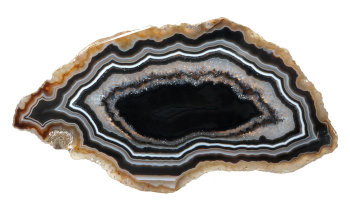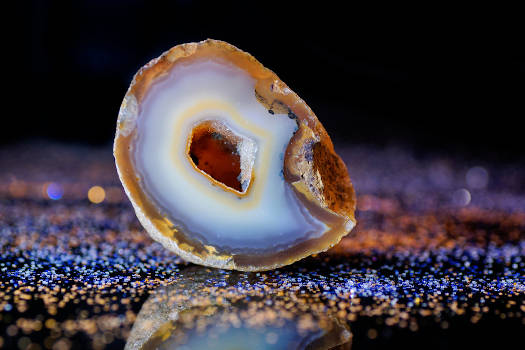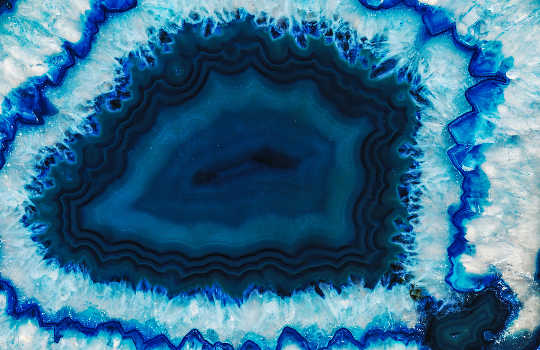If you’ve ever seen the beautiful, swirling stone around the hollow heart of a geode, you’ve seen agate. It’s been used by artisans for intaglio carving, jewelry making, and crafting housewares like cups and vases.
The colors, forms, and interior structures of agate stones are almost limitless — from dendritic agate’s complex, branching structures, to the fossilized mollusks inside Turritella agate.
About Agate
Agate is a broad category of silicon dioxide based rocks, chiefly made up of quartz and chalcedony. They usually show up in pre-existing host rocks, usually as round nodules within the holes of volcanic rocks.
This happens because gases form hollow areas in these rocks as lava cools, and these holes then fill with liquid silicate material. Agate is also sometimes found in sedimentary rock, usually occupying holes left behind by decaying organic matter.

Since agate is a broad category, it’s worth breaking it down into its various subtypes:
- Blue lace agate is found chiefly in Africa. It features lacy bands, chevrons, loops, and zigzags of alternating light blue, blue grey, and white.
- Botswana agate, often sold as banded agate, is from Botswana. It displays boldly contrasting bands of black, brown, and grayish purple.
- Brazilian agate is from Brazil. This frequently appears as large geodes of alternating layers of brown, white, gray, and clear quartz.
- Carnelian agate is bright reddish orange.
- Cold water agates are one of the subtypes found in sedimentary stones. they are typically less colorful, lacking the iron oxides and other materials that give some agates their bright bands.
- Crazy lace agate is from Mexico. This exhibits a complex pattern similar to blue lace agate, but is usually brightly colored (especially red and white).
- Dendritic agate is marked by branching tree- or fern-like patterns made of manganese and iron oxides.
- Enhydro agate contains small inclusions of water. These appear as clear bubbles, which often have a round gas bubble inside. When tilted, these gas bubbles move within the water.
- Fire agate displays an internal iridescence, or fire.
- Moss agate is somewhat similar to dendritic agate. Rather than branching structures, moss agate has a green, mossy appearance.
- Suleiman agate is a striking variety of often deep black agate, frequently banded with white.
- Turritella agate contains the shells of extinct, spiral-shaped mollusks called Elimia tenera.
There are several kinds of agate beyond these, many of which are region-specific. Outside of differences in color, the minor variations between them generally aren’t very significant to healers or magical practitioners.
See also: Check out Agate stones here.
Agate Healing Properties & Benefits
Agate healing is a complex subject. There are so many types, each one has its own specialization when it comes to emotional and physical healing.
In general, agate is considered an excellent stone for grounding and connecting to Earth energies, though some (like blue lace and fire agate) have other elemental healing associations.
Most agates are generally used for grounding feelings of anxiety and stress. It’s considered a “lower energy” stone, which makes it excellent for very sensitive people — unlike higher vibration crystals, it has a very gentle action.
It’s an excellent stone for balancing mind, body, and spirit, and works well with a variety of other stones.
Specific varieties of agate have their own healing properties. Some include:
- Botswana agate. This variety is said to help with depression, boost creativity, and create solutions to problems. Physically, it’s considered beneficial to smokers.
- Blue lace agate. This stone is considered very cooling and calming, and is said to be helpful for anxiety disorders. Physically, it’s often used for healing problems with the throat, broken bones, and thyroid issues.
- Dendritic agate. This agate helps people feel satisfaction, abundance, and peaceful enjoyment. Physically, it’s said to help the nerves and blood vessels.
- Fire agate. This stone promotes passion and courage, and helps with going through transitions. Physically, it’s considered a stone of youthfulness and vitality.
- Moss agate. This crystal helps refresh the emotionally tired. Physically, it’s regarded as an anti-inflammatory, immune booster, and pain reliever. It’s also said to help with infections and lower fevers.
See also: Check out Agate jewelry here.
Agate Magical Properties
Magically, agate’s properties tend to vary with its color. Green agates, like moss and dendritic varieties, are often used by green witches to help their plants thrive.
Brown agates are frequently used in spells to work with or heal animals. Suleiman agate has a reputation for keeping negative energies at bay.
Different colors also correspond to different elements. Blue stones, like blue lace agate, are regarded as water elemental stones. Red or orange crystals are fire. Brown or black are Earth. Yellow or white may be Air.

The difficulty in using agate for magic lies in the fact that many stones are dyed. Agate colors can be striking, but are generally “earthy” and natural-looking. Very bright, intense blues, yellows, and purples are almost always dyed.
For crystal workers who work with chakras, agates are generally considered to correspond to the chakra that matches their color.
Agate History & Folklore
Agate and humanity have a long history. Museums are full of ancient jewelry and carvings of this beautiful stone.
Even its common name is ancient — it’s believed that agates were given their name by Theophrastus, a Greek naturalist, after he found them along the Achates river around the 3rd-4th century BCE.
One ancient Greek natural history reference, Physiologus, mentioned agates used by pearl divers as a kind of dowsing rod for pearl-bearing oysters.
They would tie a piece of agate to a rope, and lower it into the water. As the agate turned in the tide, it was believed that it would stop moving and point in the direction of a pearl.
Pliny repeatedly mentioned various agates in his works. “Corollachates,” or coralline agate, was purported to heal stings from scorpions. Pliny believed that this only worked with agate from Sicily, as Sicilian scorpions had lost their venom.
In ancient Persia, magi were said to use agates to control storms and change the course of waterways.
Agate amulets have always been in high demand throughout history, and various areas became famed for the quality and cutting of their stones.
At once point, Germany produced amulets that protected against the evil eye. In the 16th century, Gujarat was a major center for cutting, polishing, and color-treating agates.
Agate rings have a particular historical and religious significance in Islam. The prophet Muhammad wore a silver ring set with agate and carnelian on his right hand, and it is considered sunnah (a model of behavior to follow) for modern Muslims.
How to Cleanse Agate
Since they’re silicon dioxide based, agates can handle pretty much anything quartz can.
Some methods for cleansing Agate include:
- Energy cleansing using your own personal energy field.
- Burying the stone in soil (either outside or in a potted plant), natural salt, or cleansing herbs.
- Bathing it in fresh water, salt water, or an infusion of cleansing herbs.
- Fumigating the agate with incense or cleansing herb smoke.
- “Sound bathing” the stone with music, chimes, bells, a tuning fork, or singing bowl. Avoid placing stones directly in singing bowls, as the vibrations may cause them to crack.
- Setting the stone briefly in sunlight.
- Setting it in the light of the full moon.
Specific stones are said to benefit from particular cleansing methods. For example, blue lace agate is best cleansed by placing it in the light of the moon, while dendritic agates enjoy fumigation with pine needles and moss agate should be left at the base of a tree for a full lunar cycle.
As with any stone, research what cleansing methods your specimen can handle, and use your intuition to guide you toward the most appropriate choice.
Getting Started With Agate
Agate is a very gentle stone, making it great for beginners. Unfortunately, there are a lot of artificially dyed specimens on the market that inexperienced collectors may fall for.
When choosing an agate, it’s necessary to not only find a shop that sources their stones from an ethical supplier, but to make sure that their stones haven’t been color-treated.
Whenever possible, it’s best to buy stones in person. This way, you can ask the salesperson any questions you might have about the stone’s origins or properties. You’ll also be able to experience the agate’s energy firsthand, before you bring it home.

Pick it up in your non-dominant hand, close your eyes, and see what kind of feeling it gives you. You might feel a variety of physical sensations, or even nothing at all — the important thing is that the stone should feel good, not uncomfortable, unpleasant, or like it’s trying to give you the brush off.
When you’ve chosen a stone, take it home and give it a good energetic cleansing. This will remove the effects of mining, shipping, and handling, and return it to its natural baseline. (You may wish to repeat this process any time you use your stone to heal an illness, or after coping with very strong, unpleasant emotions.)
With your agate cleansed, you can decide how you wish to work with it. The world’s your oyster! If you’ve purchased a green agate, try placing it with your houseplants for a little while and see how they respond.
If you chose a brown one, try meditating with it and seeing what kind of emotions or sensations come up.
Depending on the type of agate you’ve chosen, you can hold it in your dominant hand, visualize your intention, and program it to be anything from an abundance-drawing amulet to a protective talisman.
Agates are one of the world’s most popular and varied stones. Chances are, you can walk outside and find agate specimens right in your own neighborhood.
These stones have a very strong magical, healing, and artistic tradition behind them, so it’s very worth your while to cultivate a good working relationship. The more you handle and use your agate, the stronger its abilities will become.
As an Amazon Associate, Terravara earns from qualifying purchases at no additional cost to readers.
